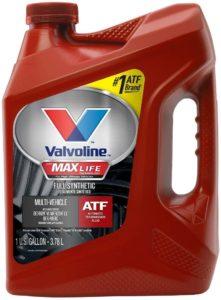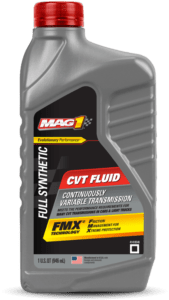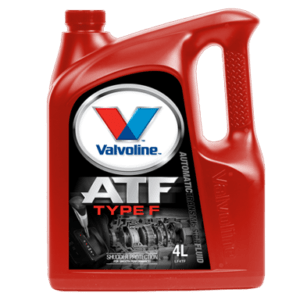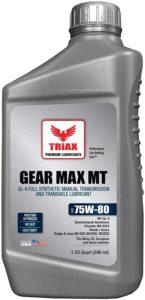For many people, changing the transmission fluid in their vehicles used to be part of the regular maintenance routine. In fact, at one time, car owners would change both the oil and transmission fluid themselves as an important step in their auto care.
Being able to check your oil, transmission fluid, water, etc., was once the first thing a new car owner learned and would practice doing so at least every few months or before any long trip.

https://www.carfax.com/blog/transmission-fluid
According to Carfax, however, this is not always necessary anymore, and in some cases, isn’t even possible. That’s because there is often no dipstick to reach the transmission fluid in the newer vehicles. They are sealed so that the car owners cannot check the fluid themselves.
Some of these cars and trucks won’t need to have their fluid changed at all, while some will need it every 15,000 miles, and others will need it every 150,000 miles. Therefore, it is important to know whether your vehicle does require regular transmission fluid changes.
You may need to take the car to a dealership or mechanic to have the fluid checked and changed.
Different Types of Transmission Fluid – Automatic Or Manual

https://www.cartalk.com/content/transmission-fluid
Before we examine the different types of transmission fluid, let’s explain what it actually is. According to CarTalk, this slick liquid was created to act as a lubricant inside a vehicle’s transmission. Lubricating the moving parts inside helps keep a transmission from locking down.
In the case of automatic transmission fluid, it also acts a bit like an engine coolant, keeping the inside of the transmission from becoming overheated and carrying power from the engine of the car to the transmission. Manual transmissions work a bit differently and require different types of fluid.
Here are some of the main functions of automatic and manual transmission fluids.:
How Automatic Transmission Fluid Works
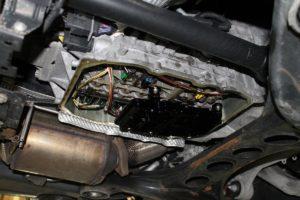
https://www.c-magazine.com/features/servicing-automatic-transmission-fluid/
As mentioned, automatic transmission fluid works much as the hydraulic fluid does. When your car needs to shift gears, the computer sends a signal to a certain solenoid in the transmission. As AMSOIL explains, the solenoid will then send the transmission fluid through various passages inside the valve body so that the correct gear will be engaged.
A series of plates located inside a clutch pack is then squeezed together by the fluid to connect the car’s engine to its transmission output shaft. Energy is then routed to the wheels, and the car’s movement is affected.
When the car is running correctly, this entire process happens so quickly that you wouldn’t even notice it. However, if there is an issue with the transmission fluid, the whole process is thrown off. Thicker transmission fluid, or high-viscosity fluid, for example, can cause the process to slow down, and the car won’t be able to shift gears smoothly.
Transmission fluid may have a higher viscosity by design. Automatic transmission fluid has a lower viscosity than manual. The fluid can also be too thick because it has accumulated foam. The bubbles in the foam will cause air pockets that will wear on the transmission gears and can damage the car. This is why foam inhibitors are necessary for automatic transmission fluid.
Aside from acting as a lubricant for the gears and parts of the transmission, automatic transmission fluid must also maintain an optimal friction level. If the clutch packs inside the transmission aren’t engaging and disengaging at the right moments, your car will not shift gears as smoothly as it should.
This is not a problem with a manual transmission, but with an automatic transmission, it is a sign that your fluid needs to be changed.
Obviously, since it acts as a lubricant inside the transmission, the automatic fluid helps protect the gears from becoming worn. This is why it is so important for all gears to stay coated with transmission fluid at all times. If you have a fluid leak and these gears are not properly coated, the transmission could lock down. In such cases, it will either have to be rebuilt or replaced altogether.
How Manual Transmission Fluid Works

Although they are not as complicated as automatic transmission fluids, manual fluids are just as important for keeping your car or truck running and shifting smoothly. Manual transmissions use different fluids for this, including heavyweight hypoid gear oil, normal motor oil, and even automatic transmission fluid.
Traditionally, manual transmission fluid was quite thick, according to Norm Reeves Volkswagen blog. This made shifting gears much more difficult, especially when temperatures dipped to lower numbers. Because of this, some car owners with manual transmissions began to use automatic transmission fluid simply because it was thinner. The owner’s manual for your vehicle should tell you which one is best for you.
There are synchronizers inside most manual transmissions—these help to “sync” the level of speed between the gears to make them shift smoothly. As you can imagine, gears spinning at different speeds would have trouble engaging properly to ensure a smooth shift.
Inside the synchronizer unit are two components known as the synchronizer ring or blocker and the sleeve. If you move the gear shift into the first gear, the sleeve will move to that position and lock onto the teeth of that gear. As you press in the clutch and move the shift to the second gear, the sleeve moves to lock onto the teeth of the second gear inside the transmission.
However, none of this can happen if the rotational speed of the sleeves and gears do not match. If the transmission fluid is too thick or of too high a viscosity, the speed will not be synched, and the shift will not take place smoothly. By the same token, if the fluid is too thin or of too low a viscosity, the gears may shift too quickly and result in “grinding the gears.”
Manual transmission fluid helps to keep any of that from happening by acting as a lubricant for the gears and sleeves and helping ensure that they are able to sync their speeds properly. By acting as a protective film, it also protects the parts from wear and tear.
Different Types of Automatic Transmission Fluids
When looking at different types of transmission fluid, it gets a bit deeper than simply “automatic vs. manual.” They both also have several types. Why are they so important?
As team Valvoline shares, the transmission of a vehicle takes the power that is generated in the engine and turns it into torque. This is in turn transferred into rotational speed for the axles that rotate the wheels. Without transmission fluid, the transmission won’t work. No matter how powerful your engine is, the car is going nowhere without the transmission.
Valvoline also points out that various types of automatic transmission fluids are available and that understanding them is important for choosing which one is right for your car. Each type of fluid was made for a different type of transmission. By using the proper type, you can add many miles to your transmission’s “lifespan.”
The three most common automatic transmission fluid types on the market are all created and marketed by three of the largest automobile manufacturers in North America. Dextron VI is from General Motors, Mercon V is from Ford, and ATF+4 is a Chrysler product.
All of these brands include friction modifiers to reduce friction on lubricated transmission parts. They are designed for the newest transmissions made today, and they all can be used in imported vehicles, as long as the owner’s manual approves of such.
Multi-Vehicle Synthetic Transmission Fluid
Just as the name suggests, multi-vehicle synthetic transmission fluid can be used for a large range of different automatic transmissions in various types of automobiles. No certain automobile manufacturer specifically licenses these products, but they were created both to improve the transmission’s performance and protect it.
Most of these transmission fluids are made of synthetic base oils. They are field-tested extensively to make sure that their performance is on target. They help protect your transmission against thermal breakdown and usually maintain most of their oxidation inhibitors even after going over 150,000 miles.
Continuously Variable Transmission Fluid (CVT)
In an effort to improve fuel economy, many automobile manufacturers are changing to continuous variable transmissions. It is important to know that automobiles with CVT require a completely different type of transmission fluid known as Continuously Variable Transmission Fluid or CVT fluid.
The continuous variable transmission is also known as the single-speed or pulley transmission. Unlike the traditional transmission, this one does not have gears and sleeves to move the automobile. It is instead moved by a belt-driven system.
There are two kinds of belts for these transmissions – the regular belt or a metal chain. Since the system depends on belts and pulleys, the transmission fluid for these cars has to produce more friction, or the belts will slip. To avoid this, these cars should only use CVT fluid. The Inside Track lists some well-known cars with this transmission type, including the Honda Accord, Toyota Prius, Subaru Legacy, Nissan Pathfinder, Mercedes Benz, both A and B Class, and several others.
Type F Transmission Fluid (Ford)
While this fluid is not used in any of the newer cars, it is still important to list it. The use of Type F transmission fluid was almost non-existent after 1980 and mostly reserved for only Ford models. This fluid might be relevant for classic car enthusiasts, but otherwise, it is an ancient artifact no longer in use.
Different Types of Manual Transmission Fluids
At one time, transmission fluids were all petroleum-based, but It Still Runs shares that this changed around 1972. This was when synthetic transmission fluid was introduced to the automotive world and quickly became popular.
The synthetic fluid does not lose its ability to coat and protect the transmission gears and parts as quickly as petroleum-based products did. This fluid is also able to transfer heat for longer periods of time at a more even level.
That said, we will look at both traditional and synthetic manual transmission fluids.
Traditional Manual Transmission Fluid
Traditional transmission fluid for a manual transmission can vary from plain old motor oil to heavyweight hypoid gear oil. Some manufacturers even suggest using automatic transmission fluid in a manual car.
The type of transmission fluid you choose to use in your manual transmission can vary according to taste, but there are several factors to consider. The choice would depend on the vehicle, the engineering, how you drive the automobile, what the manufacturer recommends, and even the climate you live in.
One of the biggest issues people have with manual transmission is friction or oxidation, causing fluid contamination. These traditional transmission fluids simply don’t retain their viscosity, and when the fluid thins, the gears and parts are not lubricated properly.
Tiny metal particles can end up in the transmission if not taken care of. For this reason, the fluid in a manual transmission must be changed much more often than in automatic.
Synthetic Manual Transmission Fluid
Unlike petroleum-based traditional manual transmission fluids, synthetic ones are created by people. Manufactured from refined oils and treated with various chemical additives, these fluids are produced in a number of ways.
The American Petroleum Institute (API) identifies the first ones developed as Group IV oil. This particular type of synthetic manual transmission fluid comes from polyalphaolefin or POA. Synthetics that are non-POA are created from polyol esters, diesters, alkylated benzenes, and alkylated naphthalenes. These are classified by the API as Group V oils.
Using a catalytic conversion process with feedstock, hydrocracked or hydro isomerized oils are classified by the API as Group III oils. All of these synthetic manual transmission fluids are able to hold their viscosity longer and will need to be changed less often than traditional ones.
History of the Automatic Transmission
Although we have looked at transmission fluid for both manual and automatic transmissions, the truth is that the majority of the vehicles on the road today have automatic transmissions. So how did the world go from manual to automatics, and where did these transmissions get their start?
The First Automatic Transmission – The Automatic Safety Transmission
An article in Mister Transmission shares that the very first automatic transmission was designed and invented by Alfred Horner Munro. Munro was a Canadian steam engineer from Regina, Saskatchewan, who brought his invention, the Automatic Safety Transmission, or ATF, to life in 1921.
Munro patented his invention in 1923. Unfortunately, the first automatic transmission had very little power and no parking or reverse gears due to its design. It never made it big in the commercial market. Munro’s transmission used compressed air instead of hydraulic fluid, making it too weak to compete with manual transmissions.
It was offered in three General Motors models, the Oldsmobile, Buick, and Cadillac, from 1937 to 1938, but only as an upgrade option, according to Auto Service Experts.
The Hydra-Matic Transmission – A War Story

https://www.autorepairsanantonio.com/40-automatic-transmission-history
José Braz Araripe and Fernando Lehly Lemos, two Brazilian inventors, designed the first-ever automatic transmission to use hydraulic fluid. Later, the “Hydra-Matic” transmission went on the market in 1940 through Oldsmobile. This Hydro-Matic was created by Earl Thompson, an engineer at GM, who advertised it as “The greatest advance since the self-starter.”
During World War II, when automobile makers stopped building cars to build tanks, they put this transmission into those tanks. This led to high demand for Hydra-Matic transmissions by the end of the war, with over 200,000 of them being sold during that time.
The Dynaflow Two Speed Transmission
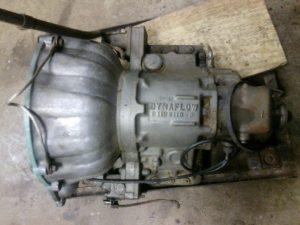
https://www.jalopyjournal.com/forum/threads/1962-buick-nailhead-dynaflow-trans-2-speed-auto.951510/
The very first automobile to feature a truly automatic transmission with a torque converter was the 1948 Buick. Known as the Dynaflow, this transmission only went in forward or reverse, but it was quite powerful for its time.
The two-speed, fully-automatic Packard was created in 1949, and the General Motor Power Glide was made in 1950. This model is still used today in many racing and top-fuel cars.
The Three Speed Transmission and the Overdrive
The first three-speed transmission was designed by Borg Warner. It used a lock-up torque converter. During the 1950s, the three-speed transmission was distributed by General Motors and popular enough to be sold in Fords, Lincolns, Bentleys, and Studebakers.
By the late 1970s, the overdrive transmission came along, featuring a lock converter. It was a four-speed transmission with higher gear ratios, making it more fuel-efficient than its predecessors.
Transmissions Today

https://pixabay.com/photos/transmission-transmission-handle-6292021/
Transmissions Today are much different than the early models. With up to 11 gear trains, electronic control solenoids, and variable speed sensors, most of these transmissions are computer-controlled.
No longer limited to one or two gears, today’s list of transmissions includes 4×4, transaxles, transfer cases, all-wheel drive, and front-wheel drive. How often the fluid should be changed can vary for each of these.
How Often Should I Change My Transmission Fluid?
The amount of time between transmission fluid changes can vary from every 15,000 miles to never. How is this possible? Well, as we have seen, there are many different types of transmissions on the road, and each of them has different designs and can use different types of fluid. How often they should be changed can depend on many factors.
For manual transmissions, it is usually suggested by manufacturers that the transmission fluid be changed at least every 30,000 to 60,000 miles. This is for regular-use vehicles that aren’t pushed hard or used too often. However, for heavily used vehicles, it may be necessary to change the transmission fluid as often as every 15,000 miles.
Automatic transmissions can be a bit trickier to determine when the transmission fluid needs to be changed. According to Toyota of Danvers, you may need a transmission flush after 30,000 miles, but it could possibly be okay waiting until you’ve been 100,000 miles. Some vehicles never need the transmission fluid changed.
A transmission flush is done by automotive technicians. They can help you determine how often you need this service, according to how often and how far you drive, whether or not you tow anything regularly, etc.
Signs You Need to Change Transmission Fluid
Since there are so many factors that determine when your transmission fluid needs to be changed, there is no clear answer to fit every vehicle.
There are, however, signs that you can look for to signify that it may be time to have your transmission serviced. If your car has a transmission fluid dipstick, you can simply check the levels by using it.
The engine should be running when you check your transmission fluid. You should have your emergency parking brake on, and the car should be on a flat surface. With gloves on, pull the dipstick out of the engine and wipe it with a lint-free cloth. Place the dipstick back in, and then pull it straight back out.
If the fluid on the dipstick is below the approved level mark, you will need to change your transmission fluid. You should also note whether or not the fluid is dirty, dark-colored, or has metal or other particles in it. If so, you will want to have your transmission flushed before adding new fluid.

